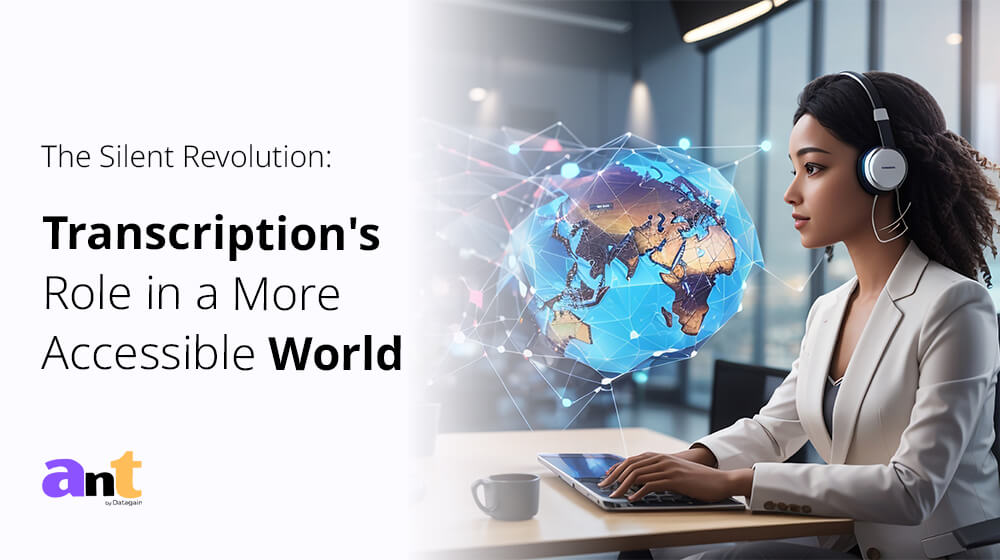Introduction
Transcription is the process of converting spoken words into written text. This seemingly straightforward task has a profound impact across various fields, including market research, user experience, corporate meetings, legal proceedings, and the international film and media industry. Understanding the role of transcription in these contexts highlights its importance and the benefits it brings to different industries. Beyond merely capturing spoken words, transcription facilitates detailed analysis, enhances accessibility, and promotes effective communication and collaboration.
The Role of Transcription in Market Research
In market research, transcription plays a crucial role in capturing detailed insights from interviews, focus groups, and surveys. Accurate transcriptions allow researchers to analyze consumer opinions, preferences, and behaviors with precision. This written data can be reviewed multiple times, enabling thorough analysis and ensuring no critical information is missed.
Transcriptions also facilitate easier sharing and collaboration among research teams, enhancing the overall quality of market research. For instance, during focus groups, participants’ interactions and reactions are rich with valuable insights. A transcript of these sessions provides a verbatim record that researchers can dissect to identify trends, sentiments, and specific feedback points. Additionally, the ability to refer back to exact phrases and terms used by participants helps in understanding the context and nuances of their responses, which can be crucial for developing marketing strategies or product improvements.
The Role of Transcription in Enhancing User Experience
User experience (UX) design relies heavily on understanding how users interact with products and services. Transcribing user feedback, usability testing sessions, and interviews helps UX designers and developers pinpoint areas for improvement. Written records of user interactions provide valuable data that can be referenced throughout the design process, ensuring that user needs and pain points are addressed effectively.
For example, during usability testing, users might vocalize their thoughts and frustrations as they navigate a website or app. Transcriptions of these sessions capture every detail of the user experience, including spontaneous reactions that might be missed in a summary. These detailed transcriptions enable UX teams to identify common issues, understand user behavior, and make data-driven decisions to enhance usability and satisfaction. By iterating on designs based on comprehensive user feedback, companies can create more user-friendly and efficient products.
The Role of Transcription in Corporate Meetings and Conferences
Corporate meetings and conferences often involve complex discussions, strategic planning, and decision-making processes. Transcribing these sessions ensures that all important points, ideas, and decisions are documented accurately. This not only aids in maintaining a record for future reference but also helps in keeping all stakeholders informed and aligned.
Transcriptions can be used to create minutes of meetings, which are essential for accountability and follow-up actions. In large corporations or during high-stakes meetings, having a verbatim transcript ensures that every detail is captured and can be revisited later. This can prevent misunderstandings, clarify action items, and serve as a reference for stakeholders who could not attend the meeting. Furthermore, transcriptions of conferences and seminars can be valuable for training purposes, allowing employees to access the knowledge shared during these events at any time.
The Role of Transcription in Legal Proceedings
In legal proceedings, accurate and detailed transcriptions are vital. Court reporters transcribe trials, depositions, and hearings, creating official records that can be referenced in future cases. These transcriptions ensure that every word spoken during legal proceedings is documented, preserving the integrity of the judicial process.
Lawyers, judges, and other legal professionals rely on these transcripts to review cases, prepare arguments, and make informed decisions. For example, during an appeal, the ability to reference the exact wording of witness testimonies or legal arguments from the original trial can be critical. Transcriptions also assist in ensuring transparency and accountability within the legal system, as they provide a permanent record that can be reviewed by oversight bodies, journalists, and the public.
The Role of Transcription in the International Film and Media Industry
In the international film and media industry, transcription serves as the foundation for creating subtitles and dubbing scripts. This allows content to reach a global audience, breaking down language barriers. Transcriptions of dialogues and narrations ensure that translations are accurate and culturally appropriate, enhancing the viewing experience for non-native speakers.
This not only expands the reach of media content but also promotes cultural exchange and understanding. For instance, a detailed transcription of a movie’s dialogue allows translators to capture the nuances and context of each line, ensuring that subtitles or dubbing maintain the original tone and meaning. This process is essential for preserving the artistic integrity of the content while making it accessible to a wider audience. Additionally, transcription aids in content creation for various platforms, such as podcasts, webinars, and online courses, by providing accurate scripts that can be adapted for different languages and formats.
The Art of Translation: Bridging Language and Culture
Translation is more than just converting words from one language to another; it involves conveying the meaning, tone, and context of the original content. Skilled translators use transcriptions as a basis to create translations that resonate with the target audience. This process requires a deep understanding of both the source and target languages, as well as the cultural nuances associated with them.
Effective translation bridges language and culture, making content accessible and relatable to diverse audiences. For example, a transcription of a culturally specific speech or presentation allows translators to identify idiomatic expressions, cultural references, and subtleties that might need adaptation. This ensures that the translated content feels natural and engaging to the target audience, rather than a literal translation that might miss the mark.
Market Research
- Researchers can shift their attention from exhaustive note-taking to comprehensive analysis, thanks to the detailed capture of interviews and focus groups by transcription services.
- By handling large volumes of audio recordings swiftly, transcription services ensure data is available for analysis without delay.
- Specialized transcriptionists familiar with market research terminology deliver high-quality transcripts that enhance research reliability.
User Experience
- User interactions are comprehensively captured by transcription services, aiding UX teams in making strategic design decisions.
- Outsourcing transcription allows UX professionals to focus on analyzing feedback and implementing improvements.
- High-quality transcripts ensure all user feedback is accurately recorded, preventing the loss of valuable insights.
Corporate Meetings and Conferences
- The detailed documentation of meetings and conferences by transcription services is crucial for ensuring accountability and aiding future reference.
- Transcriptions enable the creation of comprehensive meeting minutes and summaries, saving time for corporate professionals.
- They ensure even remote or absent stakeholders can access the full content of discussions and decisions.
Legal Proceedings
- Legal transcription services offer verbatim transcripts of court proceedings, depositions, and hearings, ensuring accuracy and completeness.
- Professional legal transcriptionists understand legal terminology and maintain confidentiality, providing reliable and secure services.
- Transcriptions assist legal professionals in case preparation, review, and appeals, ensuring meticulous documentation of all details.
Film and Media Industry
- By creating accurate scripts for subtitling and dubbing, transcription services make content accessible to a global audience.
- Experienced transcriptionists in the media industry capture the nuances of dialogue and narration, preserving the original tone and meaning.
- Transcriptions support content creators by providing written records adaptable for various formats and languages, expanding their work’s reach.
Conclusion
The role of transcription extends far beyond simply converting spoken words into text. It enhances market research, improves user experience, ensures accurate documentation in corporate and legal settings, and facilitates the global reach of media content. By recognizing and leveraging the power of transcription, industries can achieve greater efficiency, accuracy, and inclusivity in their operations. Transcription services play a pivotal role in supporting these functions, providing the expertise and reliability needed to meet the demands of various fields. Whether it’s capturing consumer insights, enhancing user experience, documenting legal proceedings, or expanding the reach of media content, transcription is an invaluable tool that drives progress and innovation across industries.
At Ant Datagain, we provide the best transcription services with a commitment to accuracy and efficiency. Our team of skilled transcriptionists is adept at handling specialized terminology across various sectors, ensuring high-quality and reliable transcripts. By choosing Ant Datagain, you can trust that your transcription needs will be met with the utmost professionalism and precision, allowing you to focus on what matters most—advancing your business and achieving your goals.
















